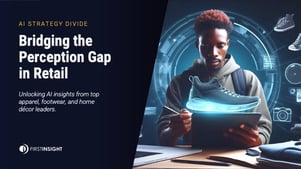| Read on mytotalretail.com |
 |
| Download PDF |
One thing retailers can count on in January is innovation. Each year, retailers across the globe gather for Retail’s BIG Show hosted by the National Retail Federation (NRF). This year’s event covered the usual topics, such as payment technologies and improving the customer experience, but also demonstrated that there’s a big shift affecting the retail landscape.
The retail industry worldwide faces several common challenges, including price pressure, improving time to market, brand definition and incorporating the voice of the customer. Exhibitors at this year’s Big Show revealed the new ways industry innovators are thinking about solving those problems, with data a key topic of conversation. Seeing all this innovation firsthand led me to reflect on the year ahead while reinforcing my perspective that all retail companies need to become data driven, or they won’t survive in the current market.
For retail, 2015 was full of new technologies taking hold and old business models rising again. But for 2016, successful retailers will be those that get back to the basics and focus on pricing, lead times and, most of all, knowing the customer. These are the four things I believe retailers must know to be successful in 2016:
1. Your lead times are shrinking: All retailers struggle with getting products out quickly. There’s a need to keep up with consumer demand, and that means developing products that will still be of interest months later. However, the globalization of the industry is a double-edged sword. For example, the lead time for developing shoes used to be four months; now it’s six because of outsourcing to multiple locations across the globe.
When manufacturing was U.S.-based, retailers were more nimble. Today the process is distributed, which results in longer lead times. For example, items are developed in Malaysia, then shipped to China for mass production, and finally make it to the U.S. for sale. But consumers’ patience wears thin quickly and by the time products hit stores, their eyes are already looking toward the next trend. The see now/buy now movement is gaining traction in fashion, as evidenced by new approaches by leaders, including Burberry, Diane von Furstenberg and Rebecca Minkoff.
To meet this challenge, retailers must be able to better predict interest and demand. The industry needs to make planning decisions based on what consumers really want, not just what the industry thinks they want. By using predictive analytics to better understand key audiences, you can avoid overbuying and stock-outs and provide your customers with products they actually want to buy, when they want to buy them.
2. The pricing pressure: In 2016, pricing will continue to have enormous pressure on the market. In fact, most economists foresee a gloomy outlook, which is already well demonstrated by current market conditions.
Jim Weber, chief executive officer of Brooks Running Company since 2001, has led the company to create a strong brand focused on the experience of runners, but doesn’t hesitate to ask the hard questions, such as, “Can millennials afford us?” Other retailers will have to face pricing pressures with the same fortitude and intense focus on the market they serve.
It will be essential to be more precise in price setting. Here too retail innovation will benefit brands by leveraging consumer insights to set prices that maximize gross margin.
3. Listen first, act second: The retail companies that are failing are those that aren’t listening to their customers. Getting information from the consumer’s perspective is vital to any brand. Customers are more connected than ever, therefore retailers must listen and engage them. Listening yields important insights that can help you be more precise in your targeting. Brands, however, must not only listen but also encourage conversation by engaging customers. You can make customers a part of the design, selection and even pricing process. Their involvement nurtures the relationship and can turn customers into brand advocates.
4. Adopt segmentation techniques: Not all customers are the same. We’ve long recognized buyer differences such as generation, but even that’s now often less relevant as customers and retailers are creating ever-smaller subsets in the market.
Today we have the technology that will help us learn more about our customers and can integrate that data with additional sources to identify and profile customer personas. The automotive industry provides an example of this precision. Ford has used segmentation to create offerings for millennials, and Porsche does the same for high-end buyers. Brands can use segmentation to create classifications of products that are perfect for a specific buyer persona. Although many retailers and brands are just beginning to understand the need for personas, using them will be a key retail development this year and a step in the right direction.
To be successful in 2016, retailers must get back to basics while moving forward with technologies that enable them to work in a smarter way. Customer information is plentiful, but brands must have the capability to turn that information into insights and act fast enough to meet today’s consumer demands.
















